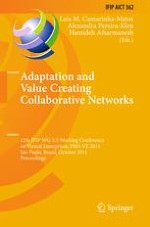This book constitutes the refereed proceedings of the 12th IFIP WG 5.5 Working Conference on Virtual Enterprises, PRO-VE 2011, held in Sao Paulo, Brazil, in October 2011. The 61 revised papers presented were carefully selected from numerous submissions. They provide a comprehensive overview of recent advances in various collaborative network (CN) domains and their applications with a particular focus on adaptation of the networks and their value creation, specifically emphasizing topics related to evolution from social networking to collaborative networks; social capital; value chains; co-creation of complex products; performance management; behavioral aspects in collaborative networks; collaborative networks planning and modeling; benefit analysis and sustainability issues, as well as including important technical and scientific challenges in applying CNs to areas such as advanced logistics networks, business process modeling, service orientation, and other emerging application domains such as ageing, tourism, crisis, and emergency scenarios.
